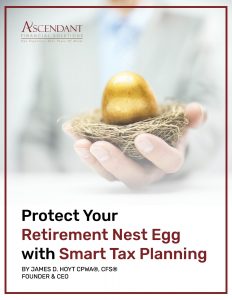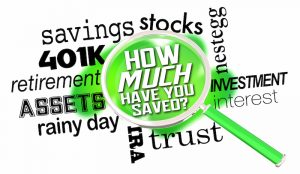By Ascendant Financial Solutions, Inc.
Why Wealth Management Without Retirement Planning Could Be a Huge Mistake

The bullish market has worn out its welcome as the fear of a recession is driving Wall Street crashes, while the supply chain in China due to Covid has investors of all ages feeling anxious. And as the global turmoil continues in Ukraine, Russia cutting off fossil fuel exports extends the energy war concern. It’s evident that anyone without a retirement plan and the right wealth manager could be putting their retirement savings in serious jeopardy.
Do you feel financially prepared for retirement?
Clear retirement planning strategies will help retirees, and high-net-worth individuals protect their assets from uncertainty. Download this complimentary eBook for guidance outlining capital gains taxes, tax deductions, and how impending income tax changes can influence your retirement.
This quick guide will show you why retirement planning is an essential piece of your overall financial health and why getting a risk assessment could be your best move yet. At Ascendant, we spend much of our time making sure clients like you minimize their tax burden.
You don’t want to rely on Social Security alone in your golden years. It’s important to note that the financial disciplines of retirement planning are for all ages, and the sooner you start, the higher your chances of reaching your retirement goals.
Chapter 1
Risk Assessment: Get a Free Risk Evaluation
Chapter 2
What is Wealth Management?
Chapter 3
What Does Retirement Planning Involve?
Chapter 4
Risk Tolerance and Your Portfolio (Changes in Risk Tolerance)
Chapter 5
Avoid These Retirement Planning Mistakes
Chapter 6
How Do I Diversify My Portfolio and How Often Should My Portfolio be Rebalanced?
Chapter 7
How Wealthy Investors Can Stay Focused in a Volatile Market
Chapter 1
Risk Assessment: Get a Free Risk Evaluation
We know it’s not easy to make sense of your money, especially as you accumulate more of it over time. And as the market rises and falls, getting a risk assessment can be a financial game-changer. Risk assessment is the process of identifying and analyzing risks connected with your capital investment.
To estimate risk for a given investment correctly, wealth managers evaluate risk to properly balance their client’s portfolios. Since risk changes along with investment performance, this should be measured and balanced regularly.
Because risk tolerance is highly connected with your age and liquid capital, it will vary per individual. Get a complimentary risk evaluation to choose the suitable matching investment options for you.
Chapter 2
What is Wealth Management?

With the ongoing task of carefully protecting and growing your hard-earned nest egg, a wealth manager is someone who can serve as your personal chief financial officer. This requires proper training, experience, research, and dedication to managing your investments. This financial ally can also help guide you through life transitions and every market condition change.
Wealth management involves crafting a balanced investment portfolio based on your financial goals, risk tolerance (ability to take on risky investments), and time horizon (how soon you will need your investment returns). As fiduciary advisors at Ascendant, we only give you financial advice in your best interest.
You will be guided through a disciplined five-step process using a comprehensive wealth management approach. As you near and enter retirement, your investment strategy may begin to shift to account for your need to take on less risk.
Chapter 3
What Does Retirement Planning Involve?
Goals and dreams for the future vary significantly among individuals, as does their risk tolerance. The ideal retirement plan for an affluent business owner will differ drastically from someone just beginning their career. These are the primary retirement planning topics that wealth managers will support you in:
Retirement Savings
Saving for retirement means using suitable vehicles to take advantage of tax breaks. For example, if you’re taking advantage of a 401(k) plan through your employer, you’ll be able to contribute $20,500 annually which can reduce your tax liability. Combine that with a Roth IRA, and tax savings can extend through your financial journey.
Investment Management
Since your risk tolerance changes over time, managing your investments is vital in retirement planning. If you’re just starting your career, you have decades of human capital at your disposal and a more extended time horizon. Therefore, taking risks in the market is sensible, as you have decades to recoup potential losses.
As retirement nears, losses can be much more impactful since you no longer have extra time to make up for them. If your risk preferences are not altered, and a 30% stock market drawdown occurs the year before you retire, your plan may be less effective. Managing investments properly means managing risk throughout your time horizon.
Most savers will decrease their risk acceptance and rotate into a more stable portfolio as their retirement date approaches.
Once you enter your golden years, how you spend your savings is nearly as crucial as accumulating them. If you have various retirement accounts on your side, like a Roth IRA, 401(k), or a taxable account, timing your asset withdrawals and sales will help determine how long your assets will last. Tax planning is the name of this game.
Tax Planning in Retirement
Tax planning might be the most impactful aspect of your post-career planning because your primary source of income has run its course. Investing in funds with low fees is essential, but so is reducing your tax obligations.
Since your pool of money to draw from is fixed, your retirement funds are what remain to live on—that and, of course, Social Security. Your financial advisor can advise you when to tap into Social Security, which investment accounts to draw from first, and how to manage unexpected expenses. In short, tax planning can prevent you from needing government supplements in your golden years.
Insurance in Retirement
As we age, the risk of an adverse health issue multiplies, so it helps to plan for at least one major hospital stay or surgery in retirement. Ask your advisor which insurance plan is right for you, especially near retirement. Of course, there are many more aspects to retirement planning, but these are the main categories.
Chapter 4
Risk Tolerance and Your Portfolio (Changes in Risk Tolerance)
This can be a highly personal matter, which we respect. That’s why it’s a top priority for us at Ascendant. It is vital to assess your risk tolerance should align with your portfolio.
Questions that you can ask yourself to understand risk tolerance, for starters, include:

- How well do I know myself?
- How much can I stand to lose emotionally?
- How much can I stand to lose financially?
- What are my investment objectives?
- When do I need the money?
And remember, since your risk tolerance changes with time and performance, it helps to have a risk evaluation regularly.
Chapter 5
Avoid These Retirement Planning Mistakes
The Federal Reserve reports that 37% of non-retired adults think their retirement savings are right on track, while 44% say their savings are not on track, and 19% are unsure. To help you sidestep the common mistakes within retirement planning, it helps to know what you must look out for.
Think before leaving a job.
Did you know that the average worker changes jobs around 12 times in their career? Some even pack up and turn the lights out without realizing they are leaving money behind in their 401(k) plan, stock options, or profit-sharing. If you are thinking about changing jobs, talk to your financial advisor about vesting, which means that you don’t have full ownership of the funds or stock that your employer “matches” until you have been employed for a set period (often five years).
Don’t drive up debt.
Try to pay off debt before you retire. Establish an emergency fund to avoid tapping into your retirement savings or last-minute debt.
Do you not have a financial plan?
To avoid running out of money in retirement, craft a plan with a wealth manager that considers your expected, planned retirement date/age, retirement location, overall health, the lifestyle you want, and lifespan. Your plan should be flexible to account for lifestyle changes.
Are you not saving yet?

Time is the best friend of compound interest, so the longer your money accumulates, the more you can have to retire on. So start cutting back on expenses and prioritizing your savings. You could save at least 10% to 15% of your total income to go into retirement savings while in the workforce as a rule of thumb.
This means contributing as much as you can to your 401(k) plan at work, with limits of $20,500 for 2022. If you are 50 or older, you can make an additional catch-up contribution of $6,500 in 2022. Be sure to take advantage of your company’s match.
If your workplace doesn’t offer a 401(k), you can open a traditional or Roth IRA and contribute a maximum of $6,000 per year (in total) to a traditional or Roth IRA for 2022. If you are 50+, you can deposit a catch-up contribution of $1,000, totaling $7,000 per year.
Don’t make unwise investment decisions.
Don’t risk your savings by investing in trends or tips from the media or unreliable sources. For those who prefer the DIY method, take precautions. Investing requires an intense learning curve, research, and time. The most successful investors usually have the trusted advice and wealth management support of a financial advisor on their side.
When was the last time your portfolio was rebalanced?
Don’t forget that portfolios need to be rebalanced to maintain the right asset mix as market conditions change and retirement nears.
Are you not tax planning?
Be aware of your tax bracket to determine how much you will owe in taxes as you migrate into your golden years. If you’re going to be in a higher tax bracket, it might be logical to invest in a Roth 401(k) or Roth IRA to pay taxes on the front end and make withdrawals tax-free.
If you think you will be in a lower tax bracket, a traditional IRA or 401(k) will be better since you can avoid high taxes on the front end and pay them when you withdraw. Avoid double taxation on borrowed funds from your 401(k) at all costs.
Cashing out savings with caution.
If you cash out part or all of your retirement fund before you reach the age of 59½, you won’t receive the full amount since 20% will be withheld for penalties and taxes. You don’t want to lose future earnings, and most people never catch back up.
Don’t forget to plan for health care costs.
The average retired couple age 65 may need approximately $300,000 (after taxes) to cover health care costs in retirement.
Don’t tap into your Social Security benefits too early.
If you can hold off on filing for Social Security until age 70, more funds will be waiting for you. Tapping in too early will result in lower payouts. Ask a financial advisor in Phoenix what this date should be for you.
Chapter 6
How Do I Diversify My Portfolio and How Often Should My Portfolio be Rebalanced?
Once you determine your risk tolerance, the percentage of your portfolio that can be invested in various asset classes, like stocks, bonds, and cash can be implemented. By diversifying your assets among multiple types of investments, you can increase the chances that your portfolio can weather the market.
The higher your tolerance, the more risk you can take. Your portfolio can be allocated toward riskier assets like stocks with a high-risk tolerance. These offer higher returns over time, with time being the key factor.
The lower your tolerance, the more conservative your portfolio should be. This could include money markets, certificates of deposit (CDs), or U.S. Treasuries for capital preservation.
An experienced wealth manager knows when to rebalance their client’s portfolios. Let’s have a conversation about rebalancing your portfolio.
Chapter 7
How Wealthy Investors Can Stay Focused in a Volatile Market
Protecting your portfolio in a hot market can cause anxiety at first. But when you work with a professional who gently guides you through the rules of investing, it becomes much easier to navigate the choppy waters. Here are some tips to protect your portfolio and remain calm:

- Don’t act on impulse or emotion
- Rebalance your portfolio or get a second opinion
- Check your portfolio diversification
- Don’t sell based on short-term market movements
- Take the long-haul perspective
At Ascendant Financial Solutions, we help high-net-worth individuals align their goals for the future and their wealth management choices, no matter how complex. We specialize in investment analysis and portfolio management in the Flagstaff and greater Phoenix areas. If you plan to retire in AZ, contact our team to discover true peace of mind within your financial life.
It’s time to stay focused on the prize that you call, retirement.
Ascendant Financial Solutions, Inc. is an independent SEC Registered Investment Advisory firm serving clients in the Flagstaff and Phoenix, Arizona areas. With more than thirty years of experience in the financial industry, we partner with families, business owners, and retirees to ascend to greater financial heights on their journey to financial freedom. No matter how complex your financial goals are, our team will rise to the challenge to help you meet your goal.
